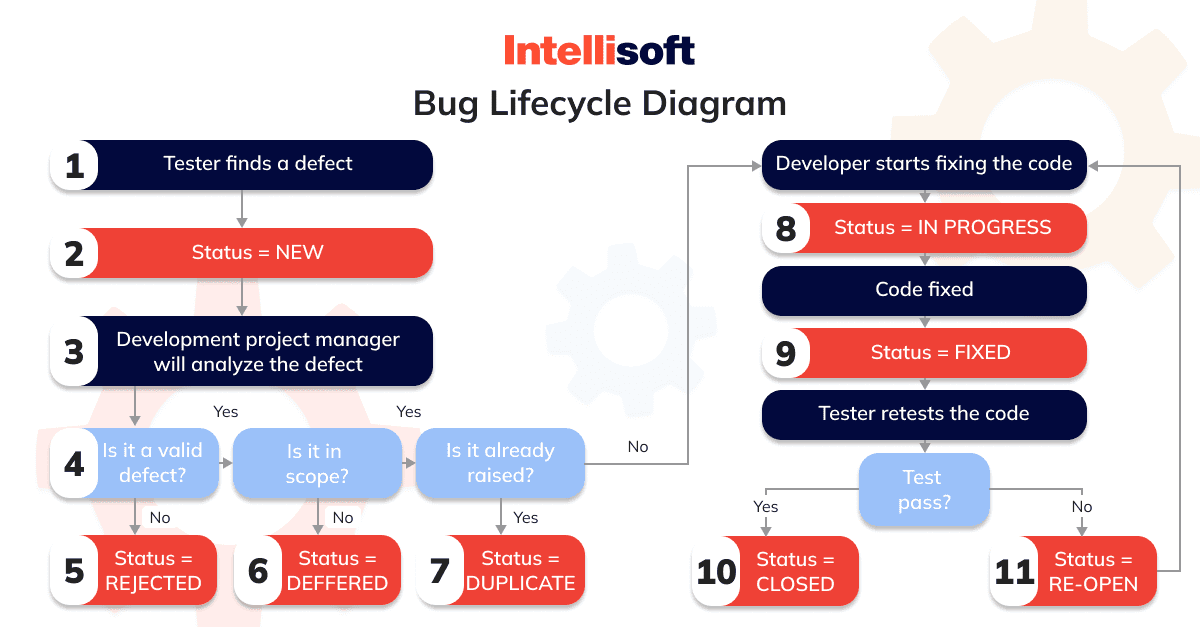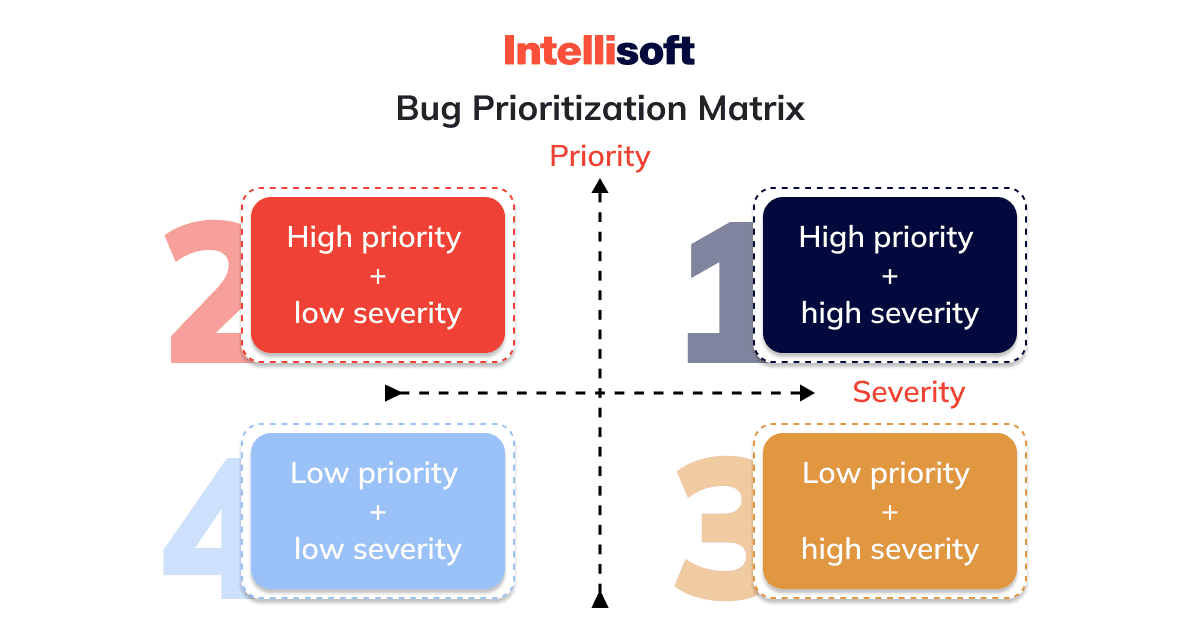Need Help With QA And Testing?
In the world of software development, the only thing as inevitable as change is the existence of bugs. A bug is a flaw or error in a program that causes it to behave in unintended ways. Bugs can lurk in even the most well-designed software. Thus, it’s crucial to have a clear and effective method for reporting and tracking them. That’s where the art of bug reporting comes into play.
Writing a good bug report is essential for anyone involved in software development. A well-written report can distinguish between a quick, painless resolution and a drawn-out, frustrating experience.
With expertise in software development, QA, and testing, the IntelliSoft team is well-equipped to guide you through the nuances of bug reporting, ensuring that your efforts contribute to your projects’ overall improvement and success. So, let’s start this journey to better software quality together.
In this article, we’ll dive deep into the world of bug reporting, exploring what makes a bug report effective and how to create one that gets results.
This comprehensive guide will cover everything from understanding what a bug is and why bug reports matter to learning how to report a bug properly, structure the information, prioritize issues, and communicate effectively with developers. As a bonus, we’ll also discuss some common pitfalls to avoid, ensuring that your bug-reporting game is spot on.
Table of Contents
Understanding Bugs
Before we dig into the mechanics of writing a bug report, we must understand what bugs are, their different types, and their common causes. This knowledge will help you better identify and describe the issues you encounter, ultimately leading to more effective reports.
Definition of a Software Bug
A bug is an error, flaw, or unintended behavior in a software application or system that causes it to produce incorrect or unexpected results. Issues can manifest in various ways, such as crashes, performance issues, security vulnerabilities, or features not working as intended.
Types of Bugs
Testers can categorize problems into several types, each of which impacts different aspects of the system, such as:
- Functionality
- Performance
- Usability
- Security
- Compatibility
Let’s take a closer look at each of them:
Functional bugs are the issues that affect the software’s functionality, causing it to behave in a manner inconsistent with its specifications or requirements.
Performance bugs cause performance-related issues, such as slow response times, memory leaks, or excessive resource consumption.
Usability bugs are related to the user interface or user experience that make the software too complex or confusing.
Security bugs cause vulnerabilities that expose the software or its users to potential security risks, such as unauthorized access, data breaches, or other malicious activities.
Compatibility bugs are issues arising from the software’s interaction with other software, hardware, or operating systems.
Now, let’s find out what causes those bugs.
Common Causes of Bugs
There are numerous potential causes for software issues, including:
Coding errors – mistakes developers make during the coding process, such as typos, incorrect use of functions, or logic errors.
Miscommunication – a lack of clear communication between team members can lead to misunderstandings and discrepancies in the software’s requirements or design.
Incomplete or outdated documentation can cause developers to build software based on incorrect or missing information.
Unanticipated user behavior – sometimes, users interact with software in ways the developers did not anticipate, leading to unexpected issues.
Complex interactions – software systems often consist of numerous components that interact in complex ways, making it challenging to predict and account for all possible scenarios.
Inadequate testing – insufficient or ineffective testing practices can fail to identify and rectify issues before deployment.
Changing requirements – modifications to the initial requirements or scope of the project can introduce new issues that developers could only see after the fact.
The Consequences of Ignoring Bugs
Failing to address software issues can have severe consequences for users and developers. Users may experience frustration, lost productivity, and even security risks. For developers and businesses, unaddressed bugs can lead to reputational losses, customer dissatisfaction, longer project timelines, and increased costs for support and maintenance. Unresolved security problems can expose sensitive data, leaving organizations vulnerable to cyberattacks and potential legal liabilities.
To mitigate these risks, you must thoroughly understand bugs and their underlying causes and develop a solid process for reporting and addressing them.
How to Write a Good Software Bug Report
Crafting an effective bug report is both an art and a science. The goal is to provide developers with enough information to identify, reproduce, and fix problems while maintaining clarity and conciseness. Let’s explore the fundamentals of a bug report, its purpose, and the essential elements that make up a high-quality report.
| Field | Value |
| Bug ID | IS-WEB-001 |
| Summary | Login button not working |
| Description | The login button does not respond when clicked, preventing users from logging in. |
| Test Steps | 1. Open Google Chrome version 99.0.4844.51 on Windows 10. |
| 2. Navigate to the login page (www.example.com/login) as an unauthenticated user. | |
| 3. Enter valid email and password. | |
| 4. Click the login button. | |
| Actual Results | The login button does not respond, and the user cannot log in. |
| Expected Results | The user should be logged in and redirected to their dashboard upon clicking the login button. |
| Reporter | Jane Doe |
| Reported Date | 2023/03/16 |
| Assignee | John Smith |
| Severity | High |
| Priority | High |
| Component | Authentication |
| Affected Version | 1.0.0 |
| Fix Version | 1.0.1 |
| Date Closed | 2023/03/20 |
| Target Version | 1.0.1 |
| Bug Status | Fixed |
| Attachments | Screenshot of the login page with the unresponsive login button. |
What is a Bug Report: Simple Definition
A bug report is a special document that details a software issue, providing information on how to reproduce the problem, what the expected behavior is, and any additional relevant details. These reports serve as the primary communication tool between the testers, developers, and other stakeholders involved in the software development process.
The Main Purpose of a Bug Report
A bug report needs to clearly describe the nature of the issue, helping developers understand the problem and its context, provide instructions for reproducing the issue, enabling developers to observe the issue firsthand and diagnose its cause, and facilitate communication and collaboration between team members, ensuring everyone stays informed of the issue’s status and progress.
A well-written report is crucial for efficient debugging, leading to faster resolution times and higher-quality software.
The Key Elements of a Bug Report (Android, iOS Apps, Web Versions)
A good report should be structured and organized to facilitate easy comprehension and quick access to essential information. Let’s explore the critical elements of a bug report and how they contribute to its effectiveness.
A comprehensive bug report includes the following:
Bug ID – a unique identifier assigned to the report for easy tracking and referencing. In today’s testing environment, testers typically utilize bug-tracking systems like Bugzilla, JIRA, or other software solutions that automatically assign an ID to the report. Manual assignment of bug IDs has become quite rare. But, if it’s necessary to set the ID manually, consider using an abbreviation for the application, such as IS-WEB for the web bug version of the IntelliSoft app or IS-MOB for its mobile counterpart. Testers should also include an index number for the specific problem, streamlining the process and saving developers significant time compared to using full titles.
Looking For QA Managers For Your Project?
Summary – a concise, informative headline that captures the issue’s essence. In the JIRA bug report template, the summary serves a similar purpose to a title and is considered one of the central components of a report. We recommend testers create concise and informative summaries. Typically, a summary comprises an Epic and a brief issue description. In JIRA, an Epic refers to a significant functional area, such as Chat or User Profile. The short explanation, consisting of one or two sentences, should convey the problem. Testers should refrain from including emotional reactions or subjective opinions in the description.
Description – a detailed explanation of the issue, including relevant background information, observations, and context. Testers should include details regarding the environment and user privileges. For instance, any prerequisites for executing test steps, such as specific configurations or test data, should be mentioned. Consider the following bug example: a mobile app crashes when transitioning to a module the user cannot access. In such cases, a bug ticket template must provide details about user privileges as prerequisites, along with the URL of the admin page for modifying user permissions.
Test Steps – a clear, step-by-step guide to reproducing the issue. This report’s section details how the problem occurs. The more comprehensive the information provided by testers, the better. Reproduction Steps should include a description of the location where to take action within the application. Testers should specify the browser version and the system state, including user type, user state, system initial data, and the page where the user was present. What tester’s actions trigger the bug?
Actual Results describe what happens when the issue occurs, including error messages or unexpected behaviors. Encourage your QA team to provide a screenshot of the Actual Result for comparison with the expected outcome.
Expected Results describe the intended behavior or outcome according to the software’s specifications or requirements. The Expected Result should represent the anticipated standard functionality under the given conditions.
Reporter – the name or identifier of the person who discovered and reported the issue. Including the reporter’s email address will help improve communication between the developer and the tester.
Reported date – the date the tester reported the bug.
Assignee is the individual or team responsible for addressing the issue.
Severity – an assessment of the bug’s impact on the software’s functionality or user experience. A scale ranges from critical (a problem obstructs essential functionality) to low (an issue is hard to reproduce; core functionality operates as expected, but minor issues arise in seldom-used functions).
Priority – a ranking that indicates the bug’s urgency, considering factors such as Severity, customer impact, and project deadlines. Bug Priority is ranked on the same scale as bug severity, from critical to low. If crucial features are non-functional, a problem is classified as ‘critical’ in both Priority and Severity. However, when users rarely interact with an inoperative feature, a critical level of Severity (due to the issue affecting functionality) and a low Priority level are assigned. For example, spelling mistakes are usually low-severity bugs, but the Priority depends on the exposure of the problem. If the mistake is in the title on the landing page, and it’s the first thing the user sees when visiting the site, then this is a high-priority bug.
Component – it’s a specific part of the software affected by the issue. Sometimes, an application consists of various components, and testers can add the affected module name or code to the component field during reporting. When bugs are assigned, and the corresponding parts are specified, it becomes more convenient for the development manager to delegate the ticket to the appropriate team members according to their expertise.
Affected version – this element indicates the software version where you found the problem. Identifying the precise application version can offer valuable information about the bug’s extent and the experiences of other users. Having this data at hand can save time and resources when addressing potential issues with an application.
Fix version – the software version in which you expect the developers to resolve the issue. Upon discovering a bug, a tester can update the software version to rectify it. It involves meticulously examining the code and determining any required modifications. After the developers resolve the issue, the tester reevaluates the application to confirm it functions as intended. If any problems arise, they can be tackled and fixed before rolling out the updated software version.
Date Closed – the date the problem was marked as resolved. The bug tracking system logs the date when a bug is closed, with any relevant notes about its resolution and the individual accountable for fixing it. This information is a valuable reference for future problem-solving efforts and a progress indicator toward enhancing software quality.
Target Version – the planned release version that will include the fix. Developers addressing a problem usually concentrate on a particular application version. This approach enables them to resolve the issue within that specific version while preventing any alterations impacting other versions. By focusing on a distinct variant of an application, developers can guarantee that all users operating on that version will benefit from the fixed bug.
Bug Status – the current status of the bug. A software bug has a lifecycle, with a condition designated according to its position in the cycle. For instance, when testers identify a new issue, they mark its status as Open. Subsequently, it progresses through various stages such as In Progress, Fixed, Won’t Fix, Accepted, Reopen, Verified, and so on. The names of these stages may differ depending on the specific bug-reporting tools used.
Attachments – any relevant files, such as screenshots, bug log files, or video recordings, that help illustrate the issue or provide additional context.

Incorporating these components into your report will ensure the development team has all the necessary information to address the issue efficiently.
Related readings:
- What Is Software Testing and When Your Product Needs It?
- DevSecOps: Defined, Explained, and Observed in One Article
- Testing IoT Devices: Why and How to Examine the Internet of Things
Effective Bug Reporting: Best Practices
Creating a comprehensive report is crucial, but following best practices to ensure your work is efficient and valuable to the development team is equally important. Let’s review various guidelines for effective bug reporting, emphasizing the importance of such factors as:
- Specificity
- Accuracy
- Clear communication
Prioritize the most critical issues
Not all bugs are created equal. Focus on reporting issues that significantly impact the user experience, system stability, or security, as developers should address these promptly.
Be specific and accurate
When describing a bug, it’s essential to be as specific and accurate as possible. Provide precise details about the issue, including the conditions under which it occurs, any error messages, and the exact steps to reproduce it. Avoid vague language and generalizations, which can lead to confusion or misinterpretation.
Use descriptive language
To help developers and testers understand the issue clearly, use descriptive language when explaining the bug. Paint a vivid picture of the problem, including the software’s behavior, the expected outcome, and any deviations from the norm. It will enable the development team to quickly grasp the nature of the issue and expedite its resolution.
Use templates and bug-tracking tools
Using a bugs report template or a bug-tracking tool can significantly improve the consistency and effectiveness of your reports. These tools provide a structured bug report format for capturing essential information and ensure that you include all necessary details. Additionally, bug-tracking tools offer features such as automatic ID assignment, status tracking, and collaboration capabilities, making it easier for teams to manage and resolve reported issues.
Test on multiple environments
Test the software on different platforms, devices, or configurations to determine if the bug is environment-specific. This information can help the development team better understand the scope of the issue and target their debugging efforts more effectively.
Ensure reproducibility
Before submitting your report, make sure you can consistently reproduce the issue. It is crucial, as developers must reproduce the bug to understand its underlying cause and develop a fix. Include step-by-step instructions in your report to ensure others can easily replicate the issue.
Keep it concise and organized
While providing sufficient detail in your bug report is essential, avoid excessive verbosity or unnecessary information. Keep your writing concise and well-organized, using clear headings, bullet points, and numbered lists where appropriate. It will make it easier for the development team to quickly grasp the nature of the issue and take appropriate action.
Demonstrate empathy and respect for the development team
Remember that developers are human, too. Approach bug reporting with a collaborative mindset and avoid using accusatory language or placing blame.
By following these best practices, you can significantly enhance the effectiveness of your reports, ensuring that your efforts contribute to the timely resolution of software issues.
Hire Best QA And Testing Talents
The Importance of Reproducing the Bug
The most crucial aspect of effective bug reporting is ensuring the development team can consistently reproduce the reported issue. Reproducing the issue helps developers and testers understand the underlying cause of the problem, identify potential fixes, and confirm the bug’s resolution. Let’s discuss why reproducing the bug is essential and provide some tips.
Why Is Reproducing the Bug Essential?
You need to be able to reproduce software problems for several reasons:
- Understanding the cause: By reproducing the issue, developers and testers can gain insights into the bug’s underlying cause and determine the most effective way to address it.
- Developing a fix: Once the cause of the issue is understood, developers can work on creating a solution or implementing a workaround.
- Verifying the resolution: After the team develops a fix, testers must reproduce the bug to confirm the issue is gone and that the solution didn’t introduce new problems.
- Improving the software: By understanding the root cause of a problem and how the tester can reproduce it, developers can proactively address similar issues in the future, leading to a more robust and reliable software application.
Tips for Reproducing the Bug
To ensure that the development team can consistently reproduce the bug, you can follow these guidelines:
- Document the steps: Provide a step-by-step guide to reproducing the bug, including any prerequisites or specific conditions under which the issue occurs.
- Test multiple scenarios: Test the issue under various conditions, such as different devices, operating systems, or configurations, to determine if it is environment-specific or consistently reproducible across different setups.
- Record your findings: Capture detailed information about your bug-testing efforts, such as the frequency of the bug, the conditions under which it occurs, and any patterns or trends you observe.
- Use screenshots or video recordings: Include screenshots or video recordings demonstrating the issue if applicable. It can help the development team visualize the issue and better understand its impact on the software’s functionality or user experience.
Ensuring that your report includes clear instructions for reproducing the issue will make it easier for the development team to diagnose and resolve the problem.
The Importance of Including Screenshots or Video Recordings
Incorporating visual aids like screenshots and video recordings into your bug reports is a game-changer that can significantly improve the efficiency of the debugging process.
Enhancing Clarity and Understanding
A well-crafted bug report provides clear, concise, and accurate information about the issue. However, even the most eloquent description may only partially convey the intricacies of a bug. Screenshots and videos provide additional evidence to your written explanation, ensuring everyone is on the same page. Including screenshots or video enables developers and QA teams to visualize the issue, understand its context, and gain insights that may not be apparent from text alone.
Accelerating the Debugging Process
Debugging can be time-consuming, especially when developers must spend extra time deciphering vague bug descriptions or attempting to reproduce issues. Screenshots and video recordings help eliminate guesswork by providing clear, unambiguous visual evidence of the problem. It allows developers to identify the root cause quickly, prioritize the issue, and implement a fix, ultimately reducing the time spent on debugging and increasing overall productivity.
Facilitating Reproduction of Issues
One of the most crucial aspects of bug reporting is providing detailed steps to reproduce the issue. However, some issues may have complex triggers or specific conditions that are challenging to communicate through text alone. By including video recordings, you offer a step-by-step visual guide allowing developers to follow along and reproduce the issue more efficiently. It ensures that no essential details are lost in translation and improves the chances of a speedy resolution.
Encouraging Collaboration and Communication
Screenshots and video recordings can also be valuable tools for fostering collaboration and communication among team members. Visual aids help bridge gaps in understanding, enabling team members with different technical backgrounds to engage in meaningful discussions about the issue. Furthermore, visual aids can help discover patterns or trends that might not be evident from textual descriptions alone, potentially unveiling deeper systemic problems that require attention.
A Picture-Perfect Bug Report
To reap the benefits of including visual aids in your reports, always ensure that your screenshots and video recordings are of high quality and accurately represent the issue. Take care to highlight the relevant elements, such as user interface components or error messages, and provide annotations or captions to guide the viewer’s attention to the crucial details. When combined with a well-written bug report, visual aids like screenshots and video recordings can transform your documentation into an invaluable resource for your development team, paving the way for faster, more effective debugging and resolution.
Prioritizing Bugs
Bug prioritization is an essential aspect of effective problem management, as it helps development teams allocate their resources and focus their efforts on the most critical issues. It’s time to discuss the importance of prioritizing bugs and outline a framework for categorizing and ranking them based on their impact and urgency.
Why is prioritizing bugs important?
There are several good reasons for prioritizing bugs:
- Resource allocation: Development teams often have limited resources and must balance problem-resolution efforts with other tasks, such as new feature development or system maintenance. Prioritizing bugs helps teams allocate resources efficiently and focus on the most pressing issues.
- Project timelines: By addressing high-priority bugs first, development teams can mitigate the risk of project delays or missed deadlines caused by critical problems.
- Customer satisfaction: Ensuring developers resolve the most severe and impactful issues quickly can improve customer satisfaction and maintain user trust in the software application.
- Quality assurance: By prioritizing bugs, teams maintain a superior level of software quality. They achieve this by tackling the most critical issues and ensuring they do not go unnoticed.
How to Prioritize Bugs
To prioritize bugs effectively, classify them based on their Severity and impact on the software. You can adapt the following general framework to your specific context or organization. In terms of Priority, you can divide all bugs into four groups:
- Critical
- High
- Normal
- Low

Critical bugs render the software unusable or cause severe data loss, security breaches, or system crashes. Developers should address these bugs immediately, as they can significantly impact users, business operations, or the organization’s reputation.
High-priority bugs severely affect the software’s functionality, performance, or user experience but do not render it entirely unusable. Developers should address these bugs ASAP to minimize user frustration and potential negative consequences.
Normal-priority bugs moderately impact the software, causing minor functional issues, usability problems, or poor performance. While developers should address these bugs promptly, they can temporarily put them on hold in favor of more critical issues.
Low-priority bugs have minimal impacts on the software and may include such problems as cosmetic issues, minor usability problems, or non-critical errors. Developers can address these bugs during regular maintenance or when resources become available, as they are unlikely to cause significant harm or user dissatisfaction.
By implementing a structured prioritization framework, development teams can efficiently manage their bug resolution efforts, ensuring that the most critical issues are approached first and minimizing the negative impact of software bugs on users and the organization.
Communicating with Developers
Effective communication between bug reporters and developers is critical for the efficient resolution of software issues. In this section, we will discuss developers’ role in resolving bugs, provide tips for establishing a productive dialogue with them, and emphasize the importance of understanding their workflows and processes.
The Role of Developers in Resolving Bugs
Developers are responsible for diagnosing and fixing software issues, which requires them to understand the underlying cause of the problem, develop a solution or workaround, and ensure that the fix does not introduce new problems. To accomplish these tasks, developers rely on the information provided in bug reports and their expertise and knowledge of the software system.

Tips for Communicating with Developers
To facilitate a productive dialogue with developers and expedite bug resolution, consider the following tips:
Be clear and concise
Provide all the necessary information in your bug report, but avoid excessive verbosity or irrelevant details. Present the information well-organized, using headings, bullet points, and numbered lists where appropriate.
Use technical language
When discussing software issues with developers, use appropriate technical language and terminology. It will help establish a common understanding of the issue and foster more efficient communication.
Provide context
Offer the context of the issue, such as the affected software component, the environment in which the tester has discovered the bug, and any relevant error messages or logs. This information can help developers pinpoint the source of the problem more quickly.
Be responsive
Respond promptly to any questions or requests for additional information from developers. It will help maintain momentum in the bug resolution process and prevent delays.
Be patient
Keep in mind that developers are often juggling multiple tasks and responsibilities. Be patient and understanding if they require additional time to address a particular issue.
Understanding Developer Workflows and Processes
If you want to communicate with developers effectively, it’s vital to have a basic knowledge of their workflows and processes. It includes being familiar with the tools and systems they use for bug tracking, version control, and collaboration, as well as the development team’s organizational structure and reporting hierarchy.
Understanding how developers work and accommodating their processes can help ensure a smoother bug resolution process and foster a positive working relationship between bug reporters and developers.
Common Mistakes in Bug Reporting
While effective bug reporting is crucial for ensuring the timely resolution of software issues, it’s equally important to avoid the common mistakes that can hinder the process. It would be a good idea to overview common pitfalls in bug reporting, discuss strategies for avoiding them, and explore the impact of these mistakes on bug resolution.
Some common mistakes in bug reporting include:
- Insufficient information: Providing too little information in a bug report can make it difficult for developers to understand the issue and reproduce it, leading to delays in resolution.
- Vague or ambiguous language: Using vague or ambiguous phraseology can cause confusion and misinterpretation, resulting in developers addressing the wrong issue or overlooking critical details.
- Poor organization: A poorly organized bug report can make it difficult for developers to quickly grasp the nature of the issue, resulting in unnecessary delays and frustration.
- Failing to reproduce the bug: A tester must ensure it’s possible to consistently reproduce the issue so developers can understand its underlying cause and develop an effective fix.
- Not prioritizing bugs: Please prioritize bugs appropriately to avoid critical issues being overlooked or under-resourced, resulting in negative consequences for users and the organization.
- Duplicating bugs: Duplicate bugs can create unnecessary obstacles in the testing cycle. While tools like Bugzilla can automatically search for duplicate bugs, manually checking for duplicates is often the most effective approach. Reviewing the list of known bugs is essential, as developers may already be aware of the issue and have chosen to address it in future releases.
How to Avoid Making Mistakes
To avoid these common pitfalls in bug reporting, consider the following strategies:
Be thorough: Provide all the necessary information in your bug report, including a clear description of the issue, steps to reproduce it, and any relevant error messages, logs, or screenshots.
Be specific and precise: Use clear and straightforward language when describing the issue, avoiding vague terms or generalizations that could lead to confusion or misinterpretation.
Organize your report: Present the information in your bug report in a clear and well-organized manner, using headings, bullet points, and numbered lists where appropriate.
Ensure reproducibility: Before submitting your bug report, ensure you can consistently reproduce the issue and provide detailed instructions.
Prioritize bugs: Implement a structured prioritization framework to address the most critical issues first and allocate resources accordingly.
Mistakes in bug reporting can significantly impact the issue resolution process, leading to delays, wasted resources, and frustration for both reporters and developers. By avoiding common pitfalls and following best practices in bug reporting, you can ensure that your efforts contribute to the timely and efficient resolution of software issues.
How to Handle Difficult Bugs
Some bugs are more challenging to diagnose and resolve than others, requiring persistence, patience, and a systematic approach to problem-solving. Let’s overview some difficult bugs, offer tips for tackling them, and emphasize the importance of maintaining a positive attitude throughout the bug resolution process.
Difficult bugs can take various forms, such as:
- Intermittent issues
- Complex interactions
- Performance problems
- Legacy system bugs.
Intermittent issues are bugs that occur sporadically or under specific conditions and can be challenging to reproduce and diagnose.
Complex interactions are issues that result from complex interactions between multiple components, systems, or layers of the software stack that can be difficult to pinpoint and resolve.
Performance problems are issues related to software performance, such as bottlenecks, slow response times, or memory leaks, which can be challenging to diagnose and address without a deep understanding of the underlying architecture and technologies.
Legacy system bugs occur in older legacy systems. They can be difficult to resolve due to outdated documentation, limited expertise, or technology constraints.

Tips for Dealing with Difficult Bugs
When faced with a challenging bug, consider the following strategies:
- Be methodical: Approach the problem systematically, breaking it down into smaller components or steps and analyzing each aspect carefully.
- Collaborate: Engage with other team members, such as developers, testers, or subject matter experts, to gather insights and perspectives on the issue.
- Leverage tools: Utilize debugging tools, logs, and monitoring systems to collect data and analyze the issue in more detail.
- Document your findings: Keep a record of your investigation, including any hypotheses, tests, results, and observations. This documentation can help you identify patterns or trends and guide your problem-solving efforts.
- Learn from the past: Review previous bug reports or resolutions for similar issues, as they may provide insights or guidance on addressing the current bug.
When dealing with difficult bugs, remaining patient and persistent in your efforts is crucial. By persevering and approaching the problem methodically, you increase the likelihood of identifying the root cause and developing an effective fix. Challenging issues can take time to diagnose and resolve, and it’s essential to maintain a positive attitude and a solution-oriented mindset throughout the process.
Some Bonus Tips for Writing a Good Bug Report
We want to share some extra tips to elevate your bug-reporting game, ensuring that you address technical aspects and contribute to a more collaborative and efficient development process. Remember, the key is writing engaging and informative text without getting bogged down in technical jargon.
- Keep it simple: While providing all relevant details is essential, keep your bug report as simple and concise as possible. This way, you will make it easier for developers to understand the issue at hand and work towards a resolution quickly.
- Stay objective: Avoid using subjective language or personal opinions when describing a bug. Stick to the facts and focus on the observable behavior of the software.
- Be patient: Resolving bugs can take time, especially if they’re complex or require input from multiple team members. Give developers the time to investigate and address the issue. You’d better follow up only if new information or a change in Priority arises.
- Collaborate: Bug reporting is a collaborative process. It may involve attending meetings, discussing the issue on chat platforms, or helping to test potential fixes. If a developer requests additional information or needs clarification, be open to working together to resolve the issue.
- Learn from feedback: If a developer provides feedback on your bug report, take it as an opportunity to learn and improve your reporting skills. It helps you grow professionally and fosters a positive working relationship with your team.
- Celebrate successes: When developers resolve a bug, take a moment to acknowledge the efforts of everyone involved. A simple “thank you” or a brief message of gratitude can go a long way in maintaining a positive team atmosphere.
Incorporate these tips into your bug reporting process, and you’ll be able to significantly impact your team’s software development journey, ultimately leading to better-quality software and happier end-users.
In Conclusion
Today, we have explored the critical role of bug reporting in ensuring the timely and efficient resolution of software issues. Writing clear and helpful bug reports is essential for anyone involved in software development. By following the tips and guidelines presented in this article, you’ll be well on your way to creating bug reports that are not only informative but also actionable for developers.
Remember, thorough and accurate bug reporting is crucial for enhancing software quality and ensuring the success of your development projects. We hope this guide has provided valuable insights and practical advice to elevate your bug-reporting skills. With this new knowledge and better understanding, you can significantly impact your team’s software development process.
If you want to know more about some aspects of software bug reporting, you can contact our team of experts 24/7 providing QA and testing services.
AboutKosta Mitrofanskiy
I have 25 years of hands-on experience in the IT and software development industry. During this period, I helped 50+ companies to gain a technological edge across different industries. I can help you with dedicated teams, hiring stand-alone developers, developing a product design and MVP for your healthcare, logistics, or IoT projects. If you have questions concerning our cooperation or need an NDA to sign, contact info@intellisoftware.net.









